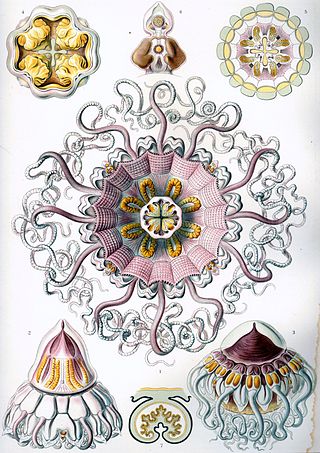
Cassiopea is a genus of true jellyfish and the only members of the family Cassiopeidae. They are found in warmer coastal regions around the world, including shallow mangrove swamps, mudflats, canals, and turtle grass flats in Florida, and the Caribbean and Micronesia. The medusa usually lives upside-down on the bottom, which has earned them the common name. These jellyfish partake in a symbiotic relationship with photosynthetic dinoflagellates and therefore, must lie upside-down in areas with sufficient light penetration to fuel their energy source. Where found, there may be numerous individuals with varying shades of white, blue, green and brown.

Crown jellyfishes are the six families of true jellyfish that belong to the order Coronatae. They are distinguished from other jellyfish by the presence of a deep groove running around the umbrella, giving them the crown shape from which they take their name. Many of the species in the order inhabit deep sea environments.

Atolla is a genus of crown jellyfish in the order Coronatae. The genus Atolla was originally proposed by Haeckel in 1880 and elevated to the monotypic family level, as Atollidae by Henry Bigelow in 1913. The six known species inhabit the mesopelagic zone. The medusae possess multiple lobes called lappets at the bell margin. Medusae also have eight tentacles, alternating with eight rhopalia, and twice as many lappets occur as tentacles.

Alatinidae is a family of box jellyfish within class Cubozoa, containing the following genera and species:

Lucernariidae is a family of stalked jellyfish containing two genera.

Limnomedusae is an order of hydrozoans.

Haliclystidae is a family of stalked jellyfish in the order Stauromedusae.

Lipkea is a genus of stalked jellyfish. It is the only genus in the monotypic family Lipkeidae. Lipkea species lack tentacles at the end of their bell.

Copula is a monotypic genus of box jellyfish in the family Tripedaliidae of the phylum Cnidaria. The only species in the genus is Copula sivickisi, a very small gelatinous, bell-shaped jellyfish with four tentacles that is active only at night. It is unusual among box jellyfish in having a mating ritual and internal fertilization. Its scientific name honours the Lithuanian zoologist Pranciškus Baltrus Šivickis.
Haliscera is a genus of hydrozoans in the family Halicreatidae.
Arctapodema is a genus of deep-sea hydrozoans in the family Rhopalonematidae.

Chrysaora chinensis, or the Indonesian sea nettle, is a species of jellyfish in the family Pelagiidae. It is native to the central Indo-Pacific region and its sting is considered dangerous.
Chrysaora fulgida, the Benguela compass jelly, is a species of jellyfish in the family Pelagiidae. Found in the southeastern Atlantic Ocean along the western coast of South Africa, its taxonomy has historically caused considerable confusion. Like other sea nettles, its sting is painful, but not generally dangerous unless there is an allergic reaction to the venom.
Chrysaora africana, the purple compass jelly, is a species of jellyfish from the family Pelagiidae. Found in the southeastern Atlantic Ocean from Gabon to the western coast of South Africa, its taxonomy has historically caused considerable confusion. Like other sea nettles, its sting is painful, but not generally dangerous unless there is an allergic reaction to the venom.

Poralia is a genus of jellyfish in the family Ulmaridae. It is a monotypic genus containing a single species, Poralia rufescens. This jellyfish is pelagic, and is found in deep water in most of the world's oceans.

Coronamedusae is a subclass of jellyfish in the class Scyphozoa. It is the sister taxon of Discomedusae and contains about 50 named species, all included in the order Coronatae. Jellyfish in this subclass are either small medusae living in shallow marine environments, or large medusae living in the deep sea.

Paraphyllina is a genus of crown jellyfish. It is the only genus in the monotypic family Paraphyllinidae, and includes three species.
Atorella arcturi is a species of crown jellyfish in the family Atorellidae. It was named in honor of the Arcturus Oceanographic Expedition, on which the type specimen was found.
Atorella octogonos is a species of crown jellyfish in the family Atorellidae. It has been found in the Bahamas.
Atorella vanhoeffeni, also known as the gold-spotted crown jelly, is a species of true jellyfish in the family Atorellidae.













